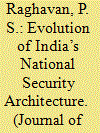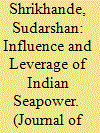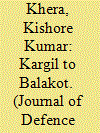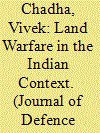|
|
|
Sort Order |
|
|
|
Items / Page
|
|
|
|
|
|
|
| Srl | Item |
| 1 |
ID:
169479


|
|
|
|
|
| Summary/Abstract |
The Kargil War of 1999 focussed the nation’s attention on shortcomings in India’s national security management system, which was largely inherited from the British in 1947. A comprehensive review resulted in a major overhaul, ensuring tighter coordination between the various security structures, reforming the higher defence organisation, and bringing in a holistic approach, recognising the political, economic, technological, ecological and sociological factors impacting on national security. A set of reviews in 2017-18 resulted in further structural reform, taking cognizance of the global geopolitical flux, a revolution in the nature of military conflict, the transformative role of technology in every aspect of internal and external security, and the challenges arising from India’s strategic ambitions. The reformed and new structures emerging from these reviews are still a work in progress. Their functioning as a smooth, well-oiled national security machinery would require a coordinated, all-of-government approach.
|
|
|
|
|
|
|
|
|
|
|
|
|
|
|
|
| 2 |
ID:
169480


|
|
|
|
|
| Summary/Abstract |
The Headquarters Integrated Defence Staff (HQ IDS) was one of the major structures raised after the Kargil conflict of 1999, representing, for the first time since independence, a step towards integration of the three armed forces with other relevant elements of power. This article situates and examines the functions of HQ IDS in the broader context of India’s national security architecture. It begins by giving a historical overview of the higher defence organisation in India, the issues pertaining to its security architecture, and the far-reaching impact of Kargil on these. It then moves on to a detailed discussion of HQ IDS, its current status and possible future trajectory. It suggests the way forward for HQ IDS and argues for the alignment of defence planning and capability development along with the wider national security paradigm.
|
|
|
|
|
|
|
|
|
|
|
|
|
|
|
|
| 3 |
ID:
169484


|
|
|
|
|
| Summary/Abstract |
Kargil was an early milestone in India’s journey towards becoming a nuclear weapons power. Two decades later, India has shed the image of a reluctant nuclear power and morphed into being a responsible one. The credit for this achievement can be traced to the wisdom that is embedded in India’s nuclear doctrine that has guided the development, growth and deployment of its nuclear wherewithal. The hallmarks of the doctrine like Civilian control, No First Use, and Credible Minimum Deterrence have endured despite internal and external pressures. However, the first leg of the operational journey will be completed only when sufficient nuclear submarines are operational, a process that should be completed sooner than later.
|
|
|
|
|
|
|
|
|
|
|
|
|
|
|
|
| 4 |
ID:
169483


|
|
|
|
|
| Summary/Abstract |
Using the Kargil conflict as a backdrop, the article explains why the leverage and influence of sea power matters. During Kargil, situated in a small area of Jammu and Kashmir, and far away from the sea, the robust deployment of the Indian Navy created politico-diplomatic pressure that contributed indirectly to the outcome. Two decades hence, the navy’s multiple strategies as doctrinally enunciated, when complemented by the broader initiatives of SAGAR and SAGARMALA, assist in India becoming a pivot for economic progress and for mutual security in the Indian Ocean Region. Going forward, the Indian Ocean will become the arena for competitive economic and security agendas of regional and extra-regional powers. This requires thinking of sea control and sea denial using available instruments imaginatively and adaptively; investing in places and bases; and create the conditions for future-readiness of a self-reliant navy that harnesses jointness effectively.
|
|
|
|
|
|
|
|
|
|
|
|
|
|
|
|
| 5 |
ID:
169477


|
|
|
|
|
| Summary/Abstract |
With the melting of snow and improvement in weather conditions, the Line of Control (LoC) in Jammu and Kashmir (J&K) that separates India and Pakistan has traditionally been a ‘hot’ place in summers, with multiple ceasefire violations by Pakistan culminating in frequent artillery duels. Over time, and well before the era of instant news, this perception of the LoC had embedded itself in the collective consciousness of the Indian public. Despite loss of life and property in the border areas and continued suffering of the local residents throughout the 1990s, the possibility of an all-out war over Kashmir had veered from the probable to the unlikely, more so after then Prime Minister Atal Bihari Vajpayee’s famous bus ride to Lahore in January 1999. Also, given the traditional tranquillity prevailing in the border districts of Kargil and Leh, the possibility of a full-fledged war in Ladakh was considered to be even more remote. All these suppositions came crashing down in the summer of 1999 after discovery of the intrusions in the Dras, Kargil and Batalik sectors, leading to the initiation of full-fledged combat operations by the Indian Armed Forces.
|
|
|
|
|
|
|
|
|
|
|
|
|
|
|
|
| 6 |
ID:
169482


|
|
|
|
|
| Summary/Abstract |
The conceptual and capability changes in a kinetic force remain intertwined with the prevailing and emerging security scenarios. Air power, a key kinetic capability, being technology dependent, needs continuous re-equipping and up gradation. The force structure and organisation too need to adapt to ensure optimal exploitation of available capability. Indian air power has transformed in the last two decades and expanded its capability in all critical facets. The Indian Air Force, in particular, has positioned itself to deliver the punch that today’s geopolitics may require: swift, deep, effective, precise, and contained in terms of collateral. With the changing character of war, there is a need to relook at the capability growth plan for air power for it to be relevant in future. With finite financial outlays, rebalancing various facets of air power is essential to achieve the desired end goal.
|
|
|
|
|
|
|
|
|
|
|
|
|
|
|
|
| 7 |
ID:
169478


|
|
|
|
|
| Summary/Abstract |
The Kargil conflict presented an opportunity for a relook at India’s national security environment in terms of defence preparedness. The Kargil Review Committee report pointed to the deficiencies in India’s security management system and gave a call for course correction especially in terms of integration of the armed forces, defence modernisation, and optimum defence budgeting and expenditure. Against this backdrop, the article undertakes a discussion of India’s national security environment by examining its long-term foreign policy and security goals as well as its possible strategic behaviour in the future. A prescriptive angle is provided by discussing the strategic options available to India in the short to medium term. The article also stresses on a greater push to domestic defence industry and manufacturing, renewed focus on maritime affairs, and the need to integrate and restructure the defence ecosystem.
|
|
|
|
|
|
|
|
|
|
|
|
|
|
|
|
| 8 |
ID:
169481


|
|
|
|
|
| Summary/Abstract |
The Indian Army is in the process of a transformative effort, envisaging changes not only at the apex level, within the Army Headquarters, but also in the field, with the concept of Integrated Battle Groups likely to be implemented soon. The past record of major changes within the army suggests an incremental approach, and also disconnect between doctrinal thought and restructuring. The only exception were the changes post the 1975 military reforms. With the Land Warfare Doctrine suggesting the future direction of the army’s war fighting priorities, can the ongoing effort at transformation succeed? This will be influenced by the ability to adapt to the changing character of war and by re-prioritising change in light of budgetary realities that are likely to remain consistent into the future. Most importantly, even as structures are created, it is the organisational culture that must drive the transformation for real change to happen.
|
|
|
|
|
|
|
|
|
|
|
|
|
|
|
|
|
|
|
|
|